#shetlander
Text

Today's Schleich is:
13232 Shetland Pony
[1996 - 2004]
31 notes
·
View notes
Text




30th January 1886 saw Betty Mouat set sail from Grutness in Shetland for Lerwick aboard the Columbine.
A wonderful tale this, and one of the most remarkable survival stories to come out of Scotland.
Betty Mouat was 59 years old in 1886. She lived in a crofthouse with her brother's family in the hamlet of Scatness--24 miles south of the town of Lerwick, Shetland. At this time, most people made the journey to the town by foot but Betty was some what disabled and preferred to travel there by sea.
The " Columbine" was a fine vessel, rigged as a cutter. The Captain and 2 crew members were experienced sailors. On January 30th, 1886, to escape bad weather, the Captain decided to sail to Lerwick from Grutness, near Betty's home. With a southerly wind, this was expected to take 2--3 hours. The Captain advised Betty not to take the journey as he anticipated a rough passage. She rejected his advice as she was anxious to see a doctor and trade some fine hand knitted goods of her own and those of other community members. So, she went below with the knitted garments and one quart of milk and 2 biscuits.
The "Columbine" set sail. Thirty minutes later, disaster struck. A heavy sea caused the main boom to swing to port.The Captain and Mate tried to repair the problem when the boom threw them overboard. The Mate managed to clamber back aboard, only to become aware that his Captain was drowning. He and the third crew member immediately launched the small lifeboat and tried to locate the Captain without success.To their horror they then realized that the"Columbine" was too far away for them to overtake her. With extreme difficulty, they headed for shore, where alarmed watchers had observed the erratic scene.
The "Columbine " owner offered a reward to anyone who would launch a boat to go after the cutter. By now, the storm made this impossible. No steamship was immediately available---although, later, several searches took place over a wide area. Wireless telegraphy had not been invented but press agency telegrams were sent to the British government and the British Consul in Norway. On February 1st. it was considered that further searches would be fruitless.
Meantime, Betty had realised that she was alone. She was seasick, cold and frightened. After screaming bitterly, she calmed down,recognising that only God could hear her. Thereafter, her religious belief helped. The storm caused her to lurch about in the cabin until she propped herself into a sitting position---holding a rope with onre hand then the other. Both hands were soon numb and blistered. She could not reach the forecastle so rationed her milk and biscuits. As the storm slowly abated, she put on the Captain's thick jacket and wound his watch daily. On February 3rd,she finished her milk and the second biscuit. Some sunshine and the sight of some land cheered her. She tried to light a lamp with some matches she had found but the light only flickered momentarily.
This nightmare scenario continued until February 6th.She later described praying and counting the stars. On her eighth day the "Columbine " struck submerged rocks near a bay in Lepsoy island off the coast of Norway.
She managed to attract attention--in spite of her weakened condition. Fishermen helped her ashore and carried her over very rough terrain to a house in Ronstad where she received great kindness and care.
Betty was now safe but her ordeal was far from over as she became a 'celebrity' of that time. She reached Edinburgh on February 24th and finally Shetland on March 16th. At all stages of her journey, the public crowded to see her. Even when she was back home, she was obliged to entertain people on a regular basis.
However, she continued her knitting and lived for another 30 years.
Her rescuers received medals from the Government. The bay in Lepsoy where the "Columbine" went aground was named "Columbukta".
You can find out more on the Scotiana web site here https://www.scotiana.com/betty-mouats-lone-voyage-a.../
12 notes
·
View notes
Photo

6K notes
·
View notes
Text

This is very cool, they look awesome.
1K notes
·
View notes
Photo

||Lorena & Luna|| - ☔️🍂 - Vanmorgen ben ik even wezen werken, vanmiddag staat er niet echt iets op de planning… even lekker uitrusten! Ik kan daar soms zoo van genieten, die rust.🥰🥰 - Na het uitrusten ga ik lekker m’n foto’s verder bewerken en kijken wat ik nog online kan bijleren over fotografie en kan investeren in cursussen en meeloopdagen etc!! - Misschien ook wel leerzaam om te vertellen, is dat je veel meer hebt aan het investeren in losse cursussen dan een volledige opleiding volgen. Dit omdat je bij cursussen etc echt al je tijd kan steken in waar je het nodig hebt. Stel je bent bijvoorbeeld al goed in composities (mijn geval), dan zou ik eerder m’n tijd willen besteden aan lightroom en photoshop (m’n bewerkprogramma’s) beter te leren kennen, dan dat ik m’n tijd verdoe aan dingen dat ik al weet.😊 - #photography #canon #canonphotography #kameraexpress #newpost #herfst #autumn #cute #horses #pferde #horsesofinstagram #shettie #shetlander #shetlandersofinstagram https://www.instagram.com/p/Ck25sIeoULS/?igshid=NGJjMDIxMWI=
#photography#canon#canonphotography#kameraexpress#newpost#herfst#autumn#cute#horses#pferde#horsesofinstagram#shettie#shetlander#shetlandersofinstagram
0 notes
Text
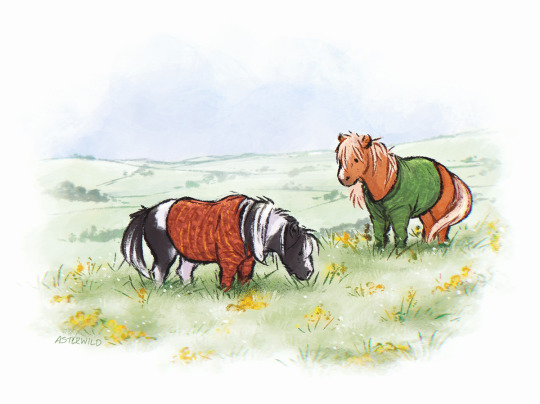
sweater season is upon us.
#shetland pony#ponies#horses#equine art#animal art#digital art#illustration#id in alt#inspired by the scotland tourism ads a few years ago!#people tagging this as jonmartin tma...i see u and i love you
9K notes
·
View notes
Text
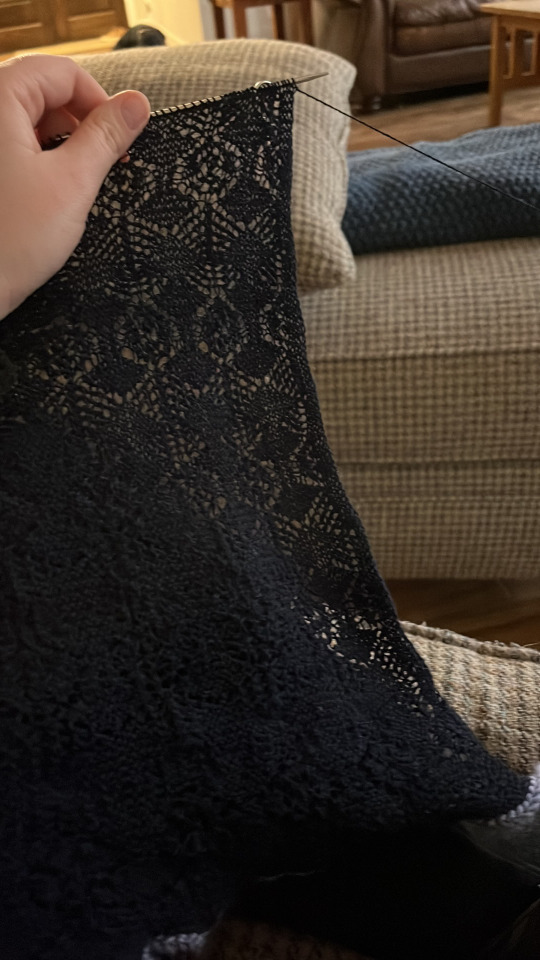
finished w/ 5th repeat!!!
#SO CLOSE to halfway done w the central panel. i am so tired i want to be working on the border!!!!!!#my post#knitting#gaada stack shawl#shetland lace
654 notes
·
View notes
Text

Horse figure of the day: Breyer #712496 Virkie: Leopard Appaloosa
481 notes
·
View notes
Text
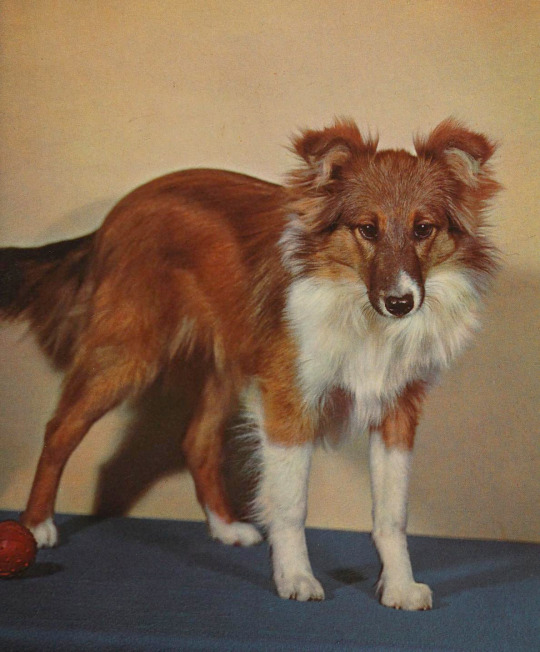
Shetland sheepdog puppy
By: Sally Anne Thompson
From: Puppies in Color
1962
#shetland sheepdog#dog#canine#carnivore#mammal#1962#1960s#Sally Anne Thompson#Puppies in Color (1962)
418 notes
·
View notes
Text

East Burn Woods // Shetland
#kiteknots#unedited#photography#nature photography#botanical#botanical blog#nikon#nikonnofilter#nikon photography#nikon d5300#green#greenspace#scotland#shetland#summer
515 notes
·
View notes
Text
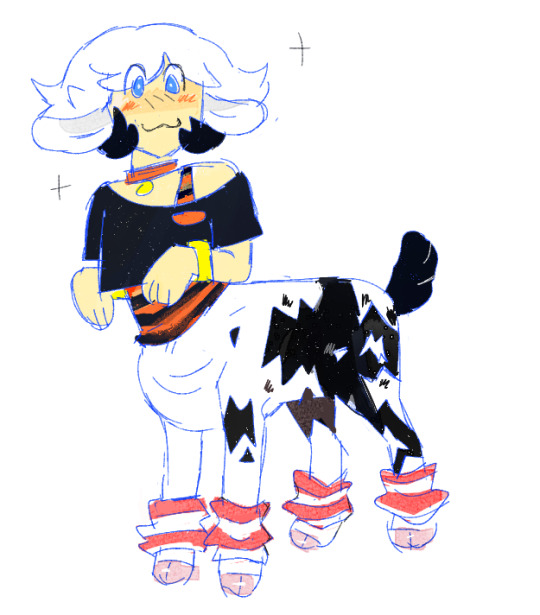
Little sheep taur guy I designed for hoofology ✌
#hoof draws#he's a sheep but i'm undecided on what breed#shetland/cheviot mix maybe?#he should be really small and polled#+ his name is fleck 👍#FORGOT 2 draw them but he has little stud earrings also
490 notes
·
View notes
Text

Today's Schleich is:
82990 Shetland Foal
[2018]
33 notes
·
View notes
Photo



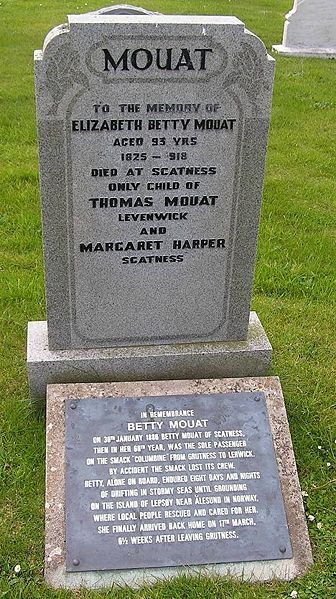
30th January 1886 saw Betty Mouat set sail from Grutness in Shetland for Lerwick aboard the Columbine.
A wonderful tale this, and one of the most remarkable survival stories to come out of Scotland.
Betty Mouat was 59 years old in 1886. She lived in a crofthouse with her brother’s family in the hamlet of Scatness–24 miles south of the town of Lerwick, Shetland. At this time, most people made the journey to the town by foot but Betty was some what disabled and preferred to travel there by sea.
The “ Columbine” was a fine vessel, rigged as a cutter. The Captain and 2 crew members were experienced sailors. On January 30th, 1886, to escape bad weather, the Captain decided to sail to Lerwick from Grutness, near Betty’s home. With a southerly wind, this was expected to take 2–3 hours. The Captain advised Betty not to take the journey as he anticipated a rough passage. She rejected his advice as she was anxious to see a doctor and trade some fine hand knitted goods of her own and those of other community members. So, she went below with the knitted garments and one quart of milk and 2 biscuits.
The “Columbine” set sail. Thirty minutes later, disaster struck. A heavy sea caused the main boom to swing to port.The Captain and Mate tried to repair the problem when the boom threw them overboard. The Mate managed to clamber back aboard, only to become aware that his Captain was drowning. He and the third crew member immediately launched the small lifeboat and tried to locate the Captain without success.To their horror they then realized that the"Columbine" was too far away for them to overtake her. With extreme difficulty, they headed for shore, where alarmed watchers had observed the erratic scene.
The “Columbine ” owner offered a reward to anyone who would launch a boat to go after the cutter. By now, the storm made this impossible. No steamship was immediately available—although, later, several searches took place over a wide area. Wireless telegraphy had not been invented but press agency telegrams were sent to the British government and the British Consul in Norway. On February 1st. it was considered that further searches would be fruitless.
Meantime, Betty had realised that she was alone. She was seasick, cold and frightened. After screaming bitterly, she calmed down,recognising that only God could hear her. Thereafter, her religious belief helped. The storm caused her to lurch about in the cabin until she propped herself into a sitting position—holding a rope with one hand then the other. Both hands were soon numb and blistered. She could not reach the forecastle so rationed her milk and biscuits. As the storm slowly abated, she put on the Captain’s thick jacket and wound his watch daily. On February 3rd,she finished her milk and the second biscuit. Some sunshine and the sight of some land cheered her. She tried to light a lamp with some matches she had found but the light only flickered momentarily.
This nightmare scenario continued until February 6th.She later described praying and counting the stars. On her eighth day the “Columbine ” struck submerged rocks near a bay in Lepsoy island off the coast of Norway.
She managed to attract attention–in spite of her weakened condition. Fishermen helped her ashore and carried her over very rough terrain to a house in Ronstad where she received great kindness and care.
Betty was now safe but her ordeal was far from over as she became a ‘celebrity’ of that time. She reached Edinburgh on February 24th and finally Shetland on March 16th. At all stages of her journey, the public crowded to see her. Even when she was back home, she was obliged to entertain people on a regular basis.
However, she continued her knitting and lived for another 30 years.
Her rescuers received medals from the Government. The bay in Lepsoy where the “Columbine” went aground was named “Columbukta”.
The bay where she came ashore in Norway is now called Columbinebukta or “Columbine Bay”: on 17th May 1986 a plaque was unveiled there commemorating the event. The croft in which Betty Mouat spent most of her life has now been extended to become Betty Mouat’s Böd, a camping böd close to Sumburgh Airport.
You can find out more on the Scotiana web site herehttps://www.scotiana.com/betty-mouats-lone-voyage-a-miracu…/
34 notes
·
View notes
Text

3K notes
·
View notes
Text
April, 2024 | Shetland lace shawl

Hi there! It’s been a while. I’ve been kept busy by all my university work…and this shawl.
The shawl is knitted to celebrate the wedding of my friend (now friends, I should say). A wedding is really the perfect excuse for all the heritage crafts and heirloom projects that might seem too serious to gift in other occasions. I did ask the recipient beforehand if she would like it, though, and I was so, so honoured that I got an enthusiastic ‘yes’. I’m sure this sentiment is shared by many makers, whatever gift they are making.
Shetland fine openwork, a knitted lace, seems to have emerged with the beginning of the reign of Queen Victoria, who championed and popularised the craft. It was probably spread from the Isle of Unst to other parts of Shetland. What surprised me the most when I first read about it was that Shetland shawls and other lace pieces were largely exported as luxury items and rarely worn by islanders themselves. Women bought yarn from spinners and knitted mostly in their homes. They then took them to local merchants and exchange the finished objects for goods or (commonly after the 1880s) money to supplement the household income. The ‘supplement’ nature of this work probably means it was not compensated as much as a job outside the home would be for the same hours and skills. Besides, it was not always easy to spin an even 1-ply yarn at 1600 metres per 100 grams. For a piece of knitting with a large ‘plain’ area (i.e. only knit stitches), the unevenness was impossible to hide but could only be discovered after the area was worked. Then the maker had to either frog (unravel) the area or continue with the risk of the whole piece not being able to sell.
Whilst it is very reasonable to point out that Shetland ladies did not usually wear this type of lace (I’ve been to the Scottish Highlands once, in summer, and it was not fine lace weather), I imagine that at least for some, it wasn’t just about making money. Some sort of fulfilment must have been from the satisfaction of having a piece ‘properly done’ by continuing and adapting a traditional pattern, technique or material. I think this sort of satisfaction is also why many modern knitters are willing to spend hundreds of hours on lacework.
Intricate handknitted lace items can still be bought today (a quick search on Etsy would show many are form eastern European countries with a long and prominent craft tradition), but many are knitted for friends or family members. It always makes me so happy to see people share the gifts they have made, whether big or small, simple or complex. I joke with my online craft friends that no handmade fibre project can claim to be so unless they have a hair or two woven into it. It is the proof of existence for the maker, who tries to go against the irregular nature of handicrafts and, at the same time, accepts it. It is about wrapping up hours, weeks or months in one’s life, along with the songs they have listened to and the perfume they have worn and the memories they have made, and putting it squarely in someone else’s hands and saying: ‘All this, for you.’

A Wedding Shawl
I have not read anything about there being a standard form of ‘wedding shawl’ in the Shetland tradition. However, there is definitely a category of square shawls with similar sizes and a few construction methods. The samples I’ve seen mostly measure 1.5-2m on one side and have three parts: a central panel, four borders and a strip of edging. It is worked flat in garter lace from centre out.
Neither is there a standardised yarn weight. A widely available yarn is the Shetland Supreme Lace Weight 1-ply by Jamieson and Smith, which weighs at 400m/25g. The Queen Ring Shawl examined by Sharon Miller used a yarn at 700m/25g. From my experience, if you want the shawl to be a true ring shawl (i.e. you want to be able to pull the shawl through a ring) at the size of the Queen Ring Shawl (210cm on the side), go for 700m/25g or finer.
I chose a rectangular shawl because I had very limited time, but I did enlarge it because for me, an abundance of fabric does mean an abundance of cozy happiness.
Pattern
Shell Grid and Spider Webs Puzzle, pattern No.19 in the book Shetland Knitting Lace by Toshiyuki Shimada.
The names of the motifs are confusing. One motif (or two highly similar motifs) might just have two different names if they are produced in two different regions. Names do not mean everything, but I’ve had fun trying to match the motifs with names according to this article by Carol Christiansen at the Shetland Museum.
The double yarnovers (YO's) in the diamonds were called Cat's Eye, but perhaps the 'Spider Web' in the pattern name is referring to the three rows of double YO's in the centre panel. It has a really simple but effective edging.
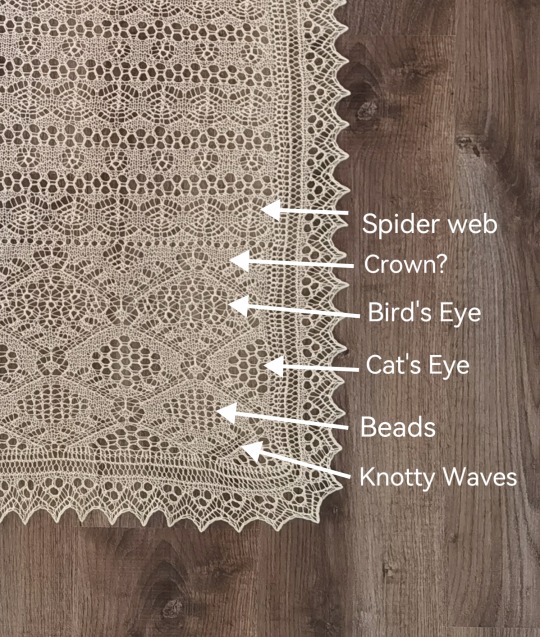
Yarn
Mermaid Lace, in colourway #naturel, sold by Great British Wool in the Netherlands. This yarn is 75% merino and 25% sea algae silk. ‘Sea algae silk’ seems to be a semi-synthetic plant fibre like viscose, with algae involved as part of the raw material. (At this price point I don’t think it has anything to do with sea silk, which is fibre produced by actual shells.) The brand name for the most popular product of its type is probably Seacell.
I bought the yarn, because I had never worked with this fibre before and was curious. What I like: it was a little cheaper than a wool/silk blend and has blocked very well. The whole skein was continuous so I didn’t have to deal with a single yarn joint. What I do not like: it lacks the sheen and smoothness of real silk and doesn’t feel as strong, although it doesn’t shed. In conclusion, I’d rather use a traditional Shetland 1-ply or another natural fibre yarn.
It's also worth mentioning that whilst I prefer to support small businesses, it was disappointing to have received a 93-gram skein when I had ordered 100 grams. It was one of those days between Christmas and the New Year and I somehow did not contact the customer service, but I really should have.
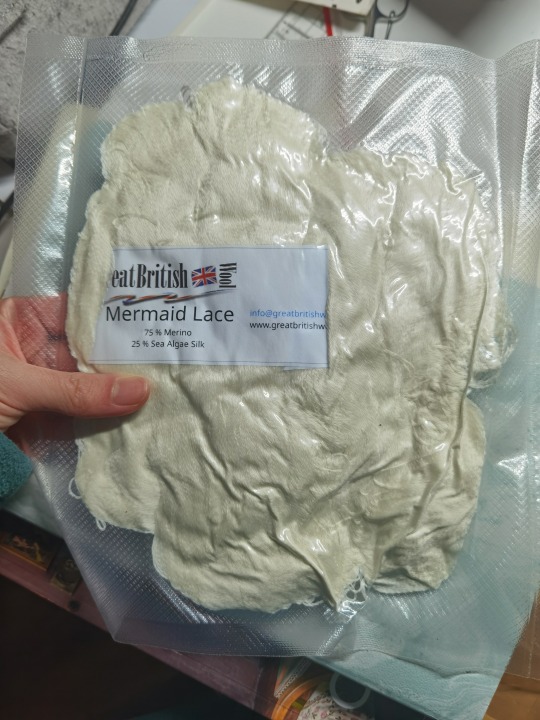
Needle
2.5mm 80cm circular needles. See modification below.
Modification
This Japanese knitting book follows Japanese sizing for knitting needles. The suggested size was no. 1=2.4mm. I figured that I could use a 2.5mm since I knitted on the tighter side, and in any case it was probably okay to make the lacework a little more open by going up a needle size.
I am not going to give out the pattern, but it is probably necessary to explain the structure of this shawl. The centre is knitted first, and then an edging is knitted onto it by picking up either live stitches or the vertical edge of the centre as you go (see schematic below). The four ‘corners’ of the edging have short-row shaping to help it lay flat. I know that traditionally people can achieve this by other methods, but I haven’t tried any of those yet.
I enlarged the pattern by increasing both the width and the length. I casted on 133 stitches instead of 101 for the centre panel and knitted Part B 8.5 times instead of 5.5. The spider web pattern in Part B requires the stitch count to be (something dividable by four) plus two, so I made one central increase before the spider web to get 134 and a central decrease after it to get it back to 133. Due to the openness of the lace, the change of one stitch is not visible.
The enlargement meant I had to recalculate the edging as well, because the number of stitches available for pick-up changed. Originally, at each corner you do two repeats with four short-row shaping each. I did 1.5 repeats following the original placement of short-row shaping in order to make the total number of repeats fit the number of edge stitches on the centre panel.
The pattern says to Kitchener-stitch the last row of the edging to the provisional cast-on. It just didn’t make sense because that would be two rows too much (the Kitchener stitch row plus the provisional cast-on row). To make the number perfectly fit, I knitted only ten rows of the last repeat (there were usually twelve in each repeat). Then I Kitchener-stitched the end to the provisional cast-on, following the lace pattern. I am quite proud of this solution because it is completely invisible.
Somewhere in the pattern it said to purl (looking from the right side). It seemed strange because the rest of the lace was entirely garter. I knitted those stitches and so far I haven’t sensed a ‘mistake’.
The pattern originally calls for 45 grams of yarn. I estimated (based on the increase of stitches in the centre panel) to need about 80 grams. I ended up using 86 grams. Besides the inaccuracies in my estimation, it was probably also because I knitted much more loosely than expected as it was difficult to tension the yarn tightly at such a weight. Like I've point out in the Yarn section above, I was lucky not to have needed more than 93 grams.
The original finished size is 53*118cm. I ended up with approximately 70*170cm.

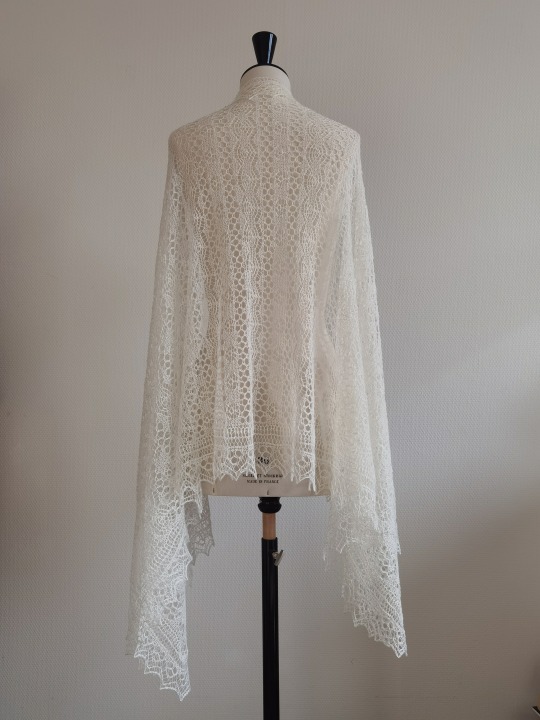


Conclusion
This shawl took about three months of my craft time i.e. one full day every week for three months and many mornings before I had to leave for university. Knitting outside my room just didn’t work because I was a) engaged in some other activities that made it difficult to steady my hands, and b) worried about putting a white shawl on any public surface.
The pattern itself is relatively straightforward. The first difficulty was, of course, to understand the instruction written in Japanese. Google translate was horrible so I had to rely on my knitting experience. Fortunately, much of the text description was also found in graphs and charts. Then I had to get my hands used to the tiny yarn. After that, it was only fiddly when I did the edging, because I had to turn about every twelve stitches, and by that time I was handling a giant cloud of stitches on my lap. It did give me a lot of time to go over my favourite documentaries and films, and the last bit of edging was surprisingly quick!
Traditionally, Shetland shawls could be sent back to the maker for maintenance. I think it only fair for me to offer that too because I don’t want a gift to become a trouble (same as how you do not use non-machine-washable yarn for baby knits).
In general, I am very pleased with this shawl. It does pass the ring test, despite not being a traditional wedding shawl size or thickness. I do have a whole lot of actual Shetland 1-ply in my stash, so I am really looking forward to taking my Queen Ring Shawl project out of hibernation in the near future.

Reference list for Introduction
Christiansen, Carol. Shetland fine lace knitting: Recreating patterns from the past. Marlborough: Crowood, 2024.
Mann, Joanna. 'Knitting the Archive: Shetland Lace and Ecologies of Skilled Practice'. Cultural Geographies 25, no. 1 (January 28, 2017): 91–106. https://doi.org/10.1177/1474474016688911.
351 notes
·
View notes
Photo

||Luna|| - ☔️🍂 - #photography #canon #canonphotography #herfst #autumn #autumnleaves #shetlander #shetland #blackhorse #newpost #horsesofinstagram #kameraexpress https://www.instagram.com/p/Ck0HqBpoY3N/?igshid=NGJjMDIxMWI=
#photography#canon#canonphotography#herfst#autumn#autumnleaves#shetlander#shetland#blackhorse#newpost#horsesofinstagram#kameraexpress
0 notes